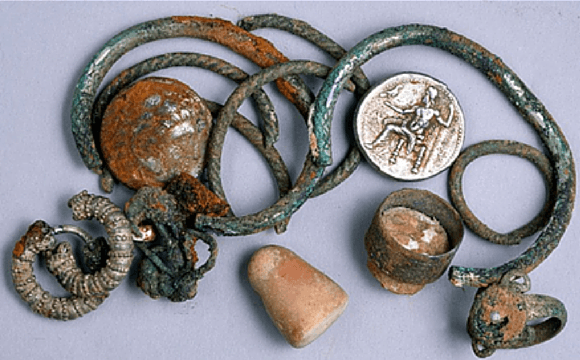
Few hobbies are as exciting as spelunking, exploring sometimes-untouched caves, delving as deep as courage allows. And occasionally these explorers find more than adventure below the earth. For example, some spelunkers recently made the discovery of a lifetime.
Reuven Zakai, his adult son Hen Zakai and their friend Lior Zhalony are experienced spelunkers. In fact, they’re members of the Israeli Caving Club. Recently, the three men were deep in a stalactite cave in northern Israel, investigating an upcoming outing with their club. While exploring, Hen Zakai squeezed through one of the smallest openings deep in the cave. What he discovered may very well have been unseen by human eyes for over 2,000 years.
He found two silver coins and a small pouch. Inside the pouch were pieces of jewelry. Sensing the importance of this discovery, the men left the artifacts where they’d found them and immediately reported the find to the Israeli Antiquity Authority (IAA).
The IAA and some members of the Israeli Caving Club made a second trip to the cave soon after the initial discovery. There they found the aforementioned coins and pouch, and several more artifacts, including a collection of agates, an oil lamp and a pair of silver earrings. But why were these valuables stashed so deep in a cave and never recovered by their owner?
“The valuables might have been hidden in the cave by local residents who fled there during the period of governmental unrest stemming from the death of Alexander (the Great), a time when the Wars of the Diadochi broke out in Israel between Alexander’s heirs following his death,” an IAA archeologist explained. “Presumably the cache was hidden in the hope of better days, but today we know that whoever buried the treasure never returned to collect it.”
Archeologists have already given some approximate dates for the artifacts. The coins were likely minted during the reign of Alexander the Great. As far as the other artifacts go, they range in date, starting with the Chalcolithic period around 6,000 years ago, the Early Bronze Age about 5,000 years ago, the Biblical period 3,000 years ago, and the Hellenistic period roughly 2,300 years ago.
While the age of the objects found in the cave may be easily dated, the length of time the hoard has been hiding in the cave is unclear. But not for long. Because they were found in stalactite caves, the sediment on the items will provide clues to geologists about how long the items remained underground. Perhaps the timeline will help shed some light on why the valuables were hidden away for so many years.
Like this? Read Diver Accidentally Finds 2,750-Year-Old Coin.
Liberty Coin & Currency specializes in rare coins and currency. We are a family owned business located in Portland and Vancouver. We are also gold, silver, diamond, currency and jewelry buyers. Visit us first for a free evaluation.
Like this post? Let us know on Facebook, Twitter, Instagram, Pinterest, or Google+.







